2004 FORD E-350 wheel
[x] Cancel search: wheelPage 124 of 256
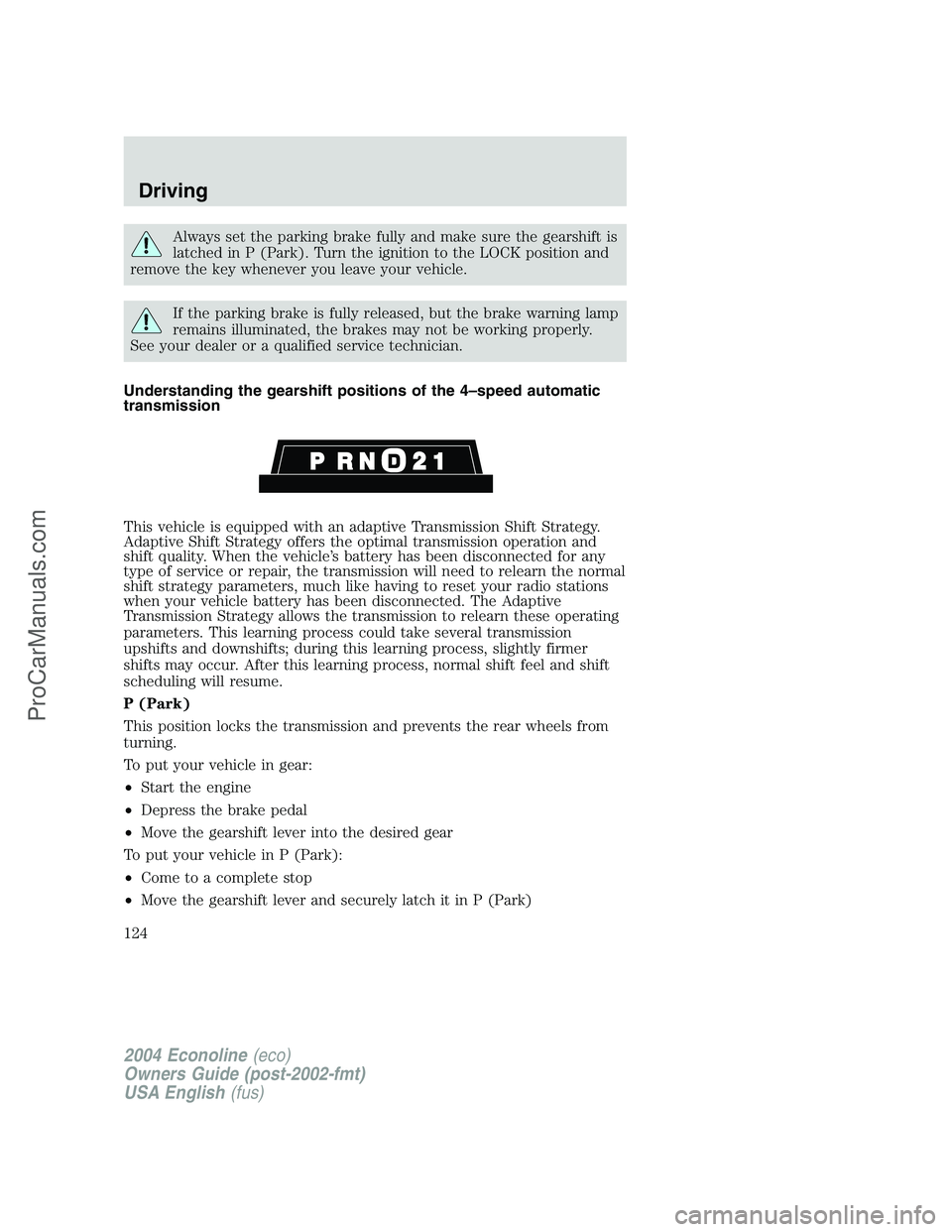
Always set the parking brake fully and make sure the gearshift is
latched in P (Park). Turn the ignition to the LOCK position and
remove the key whenever you leave your vehicle.
If the parking brake is fully released, but the brake warning lamp
remains illuminated, the brakes may not be working properly.
See your dealer or a qualified service technician.
Understanding the gearshift positions of the 4–speed automatic
transmission
This vehicle is equipped with an adaptive Transmission Shift Strategy.
Adaptive Shift Strategy offers the optimal transmission operation and
shift quality. When the vehicle’s battery has been disconnected for any
type of service or repair, the transmission will need to relearn the normal
shift strategy parameters, much like having to reset your radio stations
when your vehicle battery has been disconnected. The Adaptive
Transmission Strategy allows the transmission to relearn these operating
parameters. This learning process could take several transmission
upshifts and downshifts; during this learning process, slightly firmer
shifts may occur. After this learning process, normal shift feel and shift
scheduling will resume.
P (Park)
This position locks the transmission and prevents the rear wheels from
turning.
To put your vehicle in gear:
•Start the engine
•Depress the brake pedal
•Move the gearshift lever into the desired gear
To put your vehicle in P (Park):
•Come to a complete stop
•Move the gearshift lever and securely latch it in P (Park)
2004 Econoline(eco)
Owners Guide (post-2002-fmt)
USA English(fus)
Driving
124
ProCarManuals.com
Page 126 of 256
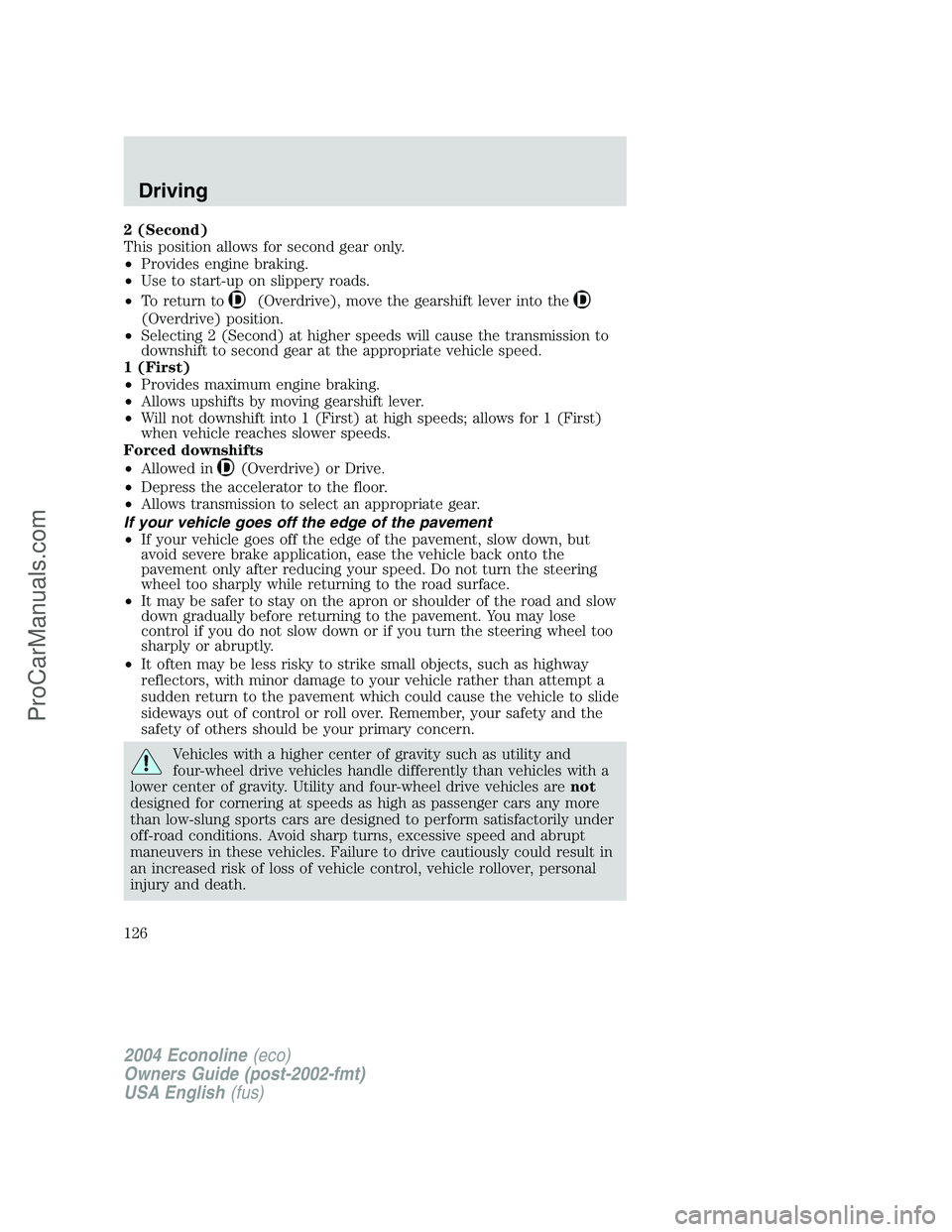
2 (Second)
This position allows for second gear only.
•Provides engine braking.
•Use to start-up on slippery roads.
•To return to
(Overdrive), move the gearshift lever into the
(Overdrive) position.
•Selecting 2 (Second) at higher speeds will cause the transmission to
downshift to second gear at the appropriate vehicle speed.
1 (First)
•Provides maximum engine braking.
•Allows upshifts by moving gearshift lever.
•Will not downshift into 1 (First) at high speeds; allows for 1 (First)
when vehicle reaches slower speeds.
Forced downshifts
•Allowed in
(Overdrive) or Drive.
•Depress the accelerator to the floor.
•Allows transmission to select an appropriate gear.
If your vehicle goes off the edge of the pavement
•If your vehicle goes off the edge of the pavement, slow down, but
avoid severe brake application, ease the vehicle back onto the
pavement only after reducing your speed. Do not turn the steering
wheel too sharply while returning to the road surface.
•It may be safer to stay on the apron or shoulder of the road and slow
down gradually before returning to the pavement. You may lose
control if you do not slow down or if you turn the steering wheel too
sharply or abruptly.
•It often may be less risky to strike small objects, such as highway
reflectors, with minor damage to your vehicle rather than attempt a
sudden return to the pavement which could cause the vehicle to slide
sideways out of control or roll over. Remember, your safety and the
safety of others should be your primary concern.
Vehicles with a higher center of gravity such as utility and
four-wheel drive vehicles handle differently than vehicles with a
lower center of gravity. Utility and four-wheel drive vehicles arenot
designed for cornering at speeds as high as passenger cars any more
than low-slung sports cars are designed to perform satisfactorily under
off-road conditions. Avoid sharp turns, excessive speed and abrupt
maneuvers in these vehicles. Failure to drive cautiously could result in
an increased risk of loss of vehicle control, vehicle rollover, personal
injury and death.
2004 Econoline(eco)
Owners Guide (post-2002-fmt)
USA English(fus)
Driving
126
ProCarManuals.com
Page 127 of 256
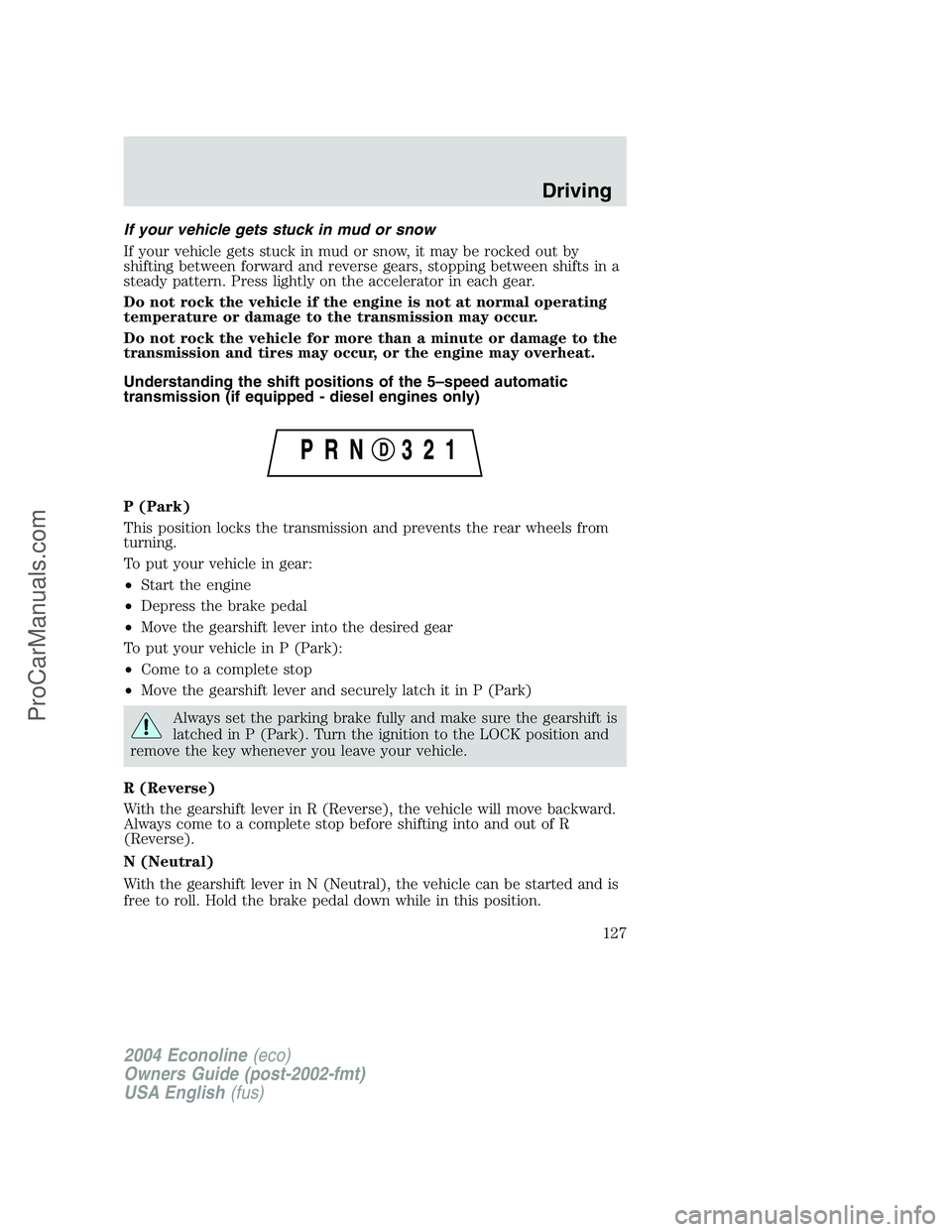
If your vehicle gets stuck in mud or snow
If your vehicle gets stuck in mud or snow, it may be rocked out by
shifting between forward and reverse gears, stopping between shifts in a
steady pattern. Press lightly on the accelerator in each gear.
Do not rock the vehicle if the engine is not at normal operating
temperature or damage to the transmission may occur.
Do not rock the vehicle for more than a minute or damage to the
transmission and tires may occur, or the engine may overheat.
Understanding the shift positions of the 5–speed automatic
transmission (if equipped - diesel engines only)
P (Park)
This position locks the transmission and prevents the rear wheels from
turning.
To put your vehicle in gear:
•Start the engine
•Depress the brake pedal
•Move the gearshift lever into the desired gear
To put your vehicle in P (Park):
•Come to a complete stop
•Move the gearshift lever and securely latch it in P (Park)
Always set the parking brake fully and make sure the gearshift is
latched in P (Park). Turn the ignition to the LOCK position and
remove the key whenever you leave your vehicle.
R (Reverse)
With the gearshift lever in R (Reverse), the vehicle will move backward.
Always come to a complete stop before shifting into and out of R
(Reverse).
N (Neutral)
With the gearshift lever in N (Neutral), the vehicle can be started and is
free to roll. Hold the brake pedal down while in this position.
2004 Econoline(eco)
Owners Guide (post-2002-fmt)
USA English(fus)
Driving
127
ProCarManuals.com
Page 129 of 256

Forced downshifts
•Allowed in D (Drive) with Overdrive or D (Drive) without Overdrive.
•Depress the accelerator to the floor.
•Allows transmission to select an appropriate gear.
DRIVING THROUGH WATER
If driving through deep or standing water is unavoidable, proceed very
slowly especially when the depth is not known. Never drive through
water that is higher than the bottom of the hubs (for trucks) or the
bottom of the wheel rims (for cars). When driving through water,
traction or brake capability may be limited. Also, water may enter your
engine’s air intake and severely damage your engine or your vehicle may
stall.Driving through deep water where the transmission vent
tube is submerged may allow water into the transmission and
cause internal transmission damage.
Once through the water, always dry the brakes by moving your
vehicle slowly while applying light pressure on the brake pedal.
Wet brakes do not stop the vehicle as quickly as dry brakes.
EMERGENCY MANEUVERS
•In an unavoidable emergency situation where a sudden sharp turn
must be made, remember to avoid“over-driving”your vehicle, i.e.,
turn the steering wheel only as rapidly and as far as required to avoid
the emergency. Excessive steering will result in less vehicle control,
not more. Additionally, smooth variations of the accelerator and/or
brake pedal pressure should be utilized if changes in vehicle speed are
called for. Avoid abrupt steering, acceleration or braking which could
result in an increased risk of loss of vehicle control, vehicle rollover
and/or personal injury. Use all available road surface to return the
vehicle to a safe direction of travel.
•In the event of an emergency stop, avoid skidding the tires and do not
attempt any sharp steering wheel movements.
Vehicles with a higher center of gravity such as utility and
four-wheel drive vehicles handle differently than vehicles with a
lower center of gravity. Utility and four-wheel drive vehicles arenot
designed for cornering at speeds as high as passenger cars any more
than low-slung sports cars are designed to perform satisfactorily under
off-road conditions. Avoid sharp turns, excessive speed and abrupt
maneuvers in these vehicles. Failure to drive cautiously could result in
an increased risk of loss of vehicle control, vehicle rollover, personal
injury and death.
2004 Econoline(eco)
Owners Guide (post-2002-fmt)
USA English(fus)
Driving
129
ProCarManuals.com
Page 132 of 256
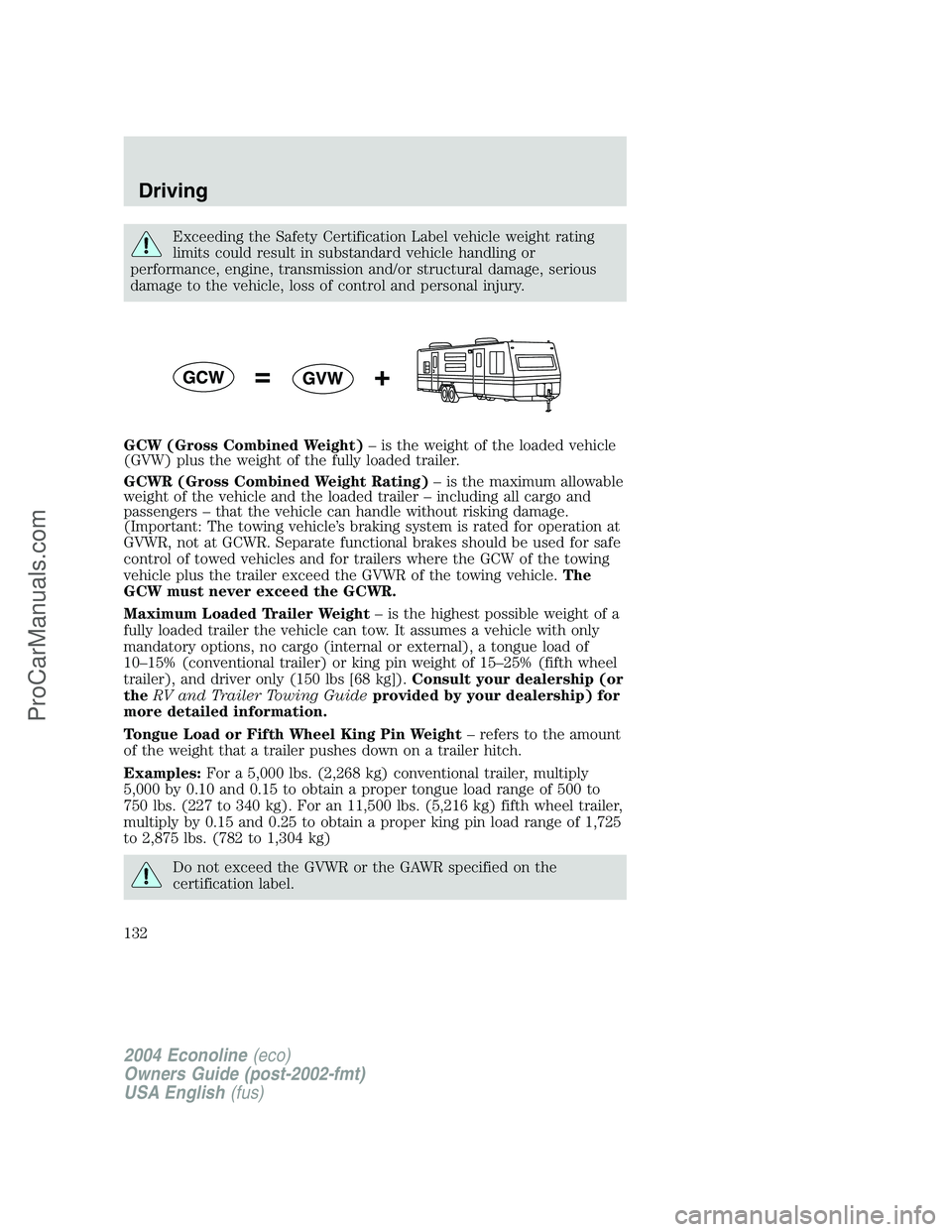
Exceeding the Safety Certification Label vehicle weight rating
limits could result in substandard vehicle handling or
performance, engine, transmission and/or structural damage, serious
damage to the vehicle, loss of control and personal injury.
GCW (Gross Combined Weight)–is the weight of the loaded vehicle
(GVW) plus the weight of the fully loaded trailer.
GCWR (Gross Combined Weight Rating)–is the maximum allowable
weight of the vehicle and the loaded trailer–including all cargo and
passengers–that the vehicle can handle without risking damage.
(Important: The towing vehicle’s braking system is rated for operation at
GVWR, not at GCWR. Separate functional brakes should be used for safe
control of towed vehicles and for trailers where the GCW of the towing
vehicle plus the trailer exceed the GVWR of the towing vehicle.The
GCW must never exceed the GCWR.
Maximum Loaded Trailer Weight–is the highest possible weight of a
fully loaded trailer the vehicle can tow. It assumes a vehicle with only
mandatory options, no cargo (internal or external), a tongue load of
10–15% (conventional trailer) or king pin weight of 15–25% (fifth wheel
trailer), and driver only (150 lbs [68 kg]).Consult your dealership (or
theRV and Trailer Towing Guideprovided by your dealership) for
more detailed information.
Tongue Load or Fifth Wheel King Pin Weight–refers to the amount
of the weight that a trailer pushes down on a trailer hitch.
Examples:For a 5,000 lbs. (2,268 kg) conventional trailer, multiply
5,000 by 0.10 and 0.15 to obtain a proper tongue load range of 500 to
750 lbs. (227 to 340 kg). For an 11,500 lbs. (5,216 kg) fifth wheel trailer,
multiply by 0.15 and 0.25 to obtain a proper king pin load range of 1,725
to 2,875 lbs. (782 to 1,304 kg)
Do not exceed the GVWR or the GAWR specified on the
certification label.
2004 Econoline(eco)
Owners Guide (post-2002-fmt)
USA English(fus)
Driving
132
ProCarManuals.com
Page 138 of 256
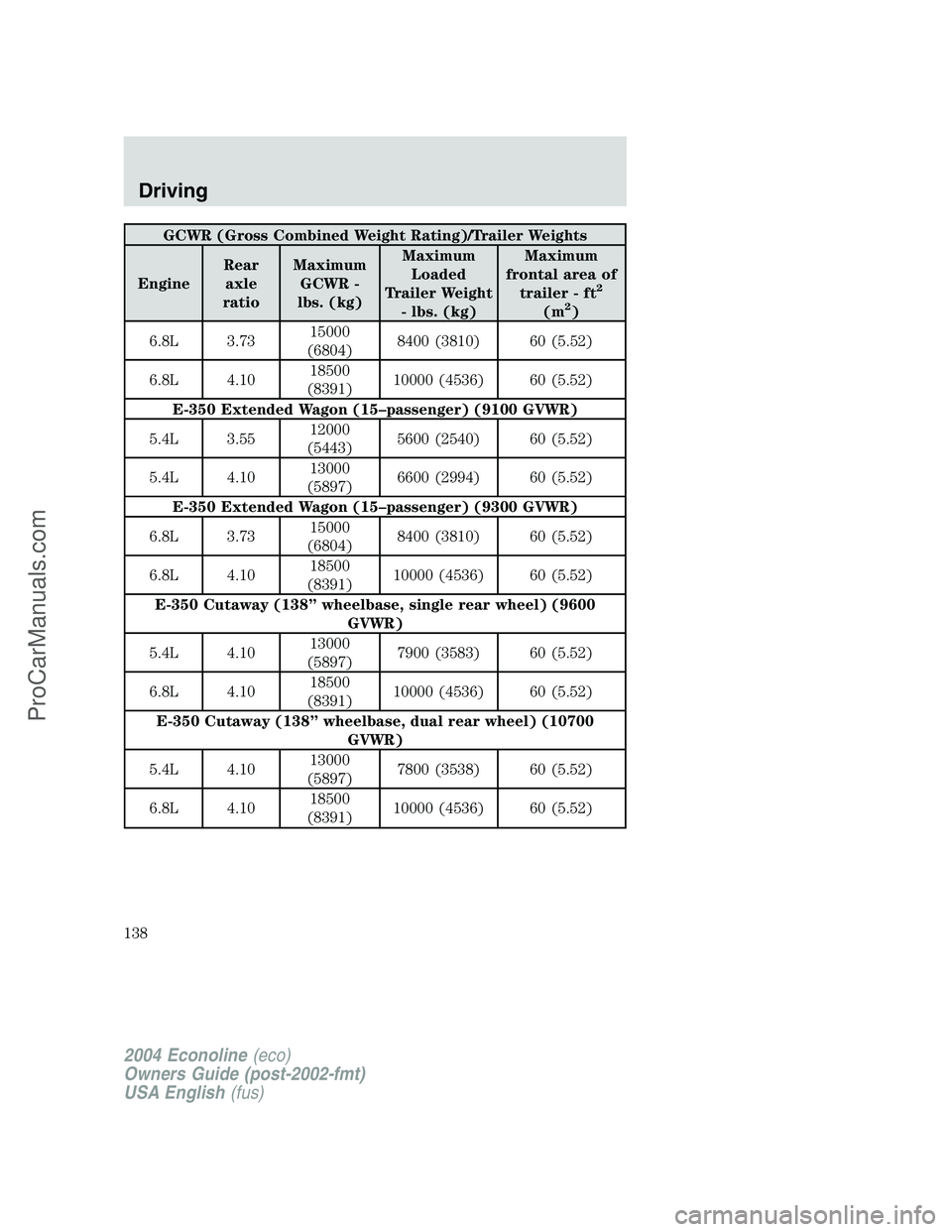
GCWR (Gross Combined Weight Rating)/Trailer Weights
EngineRear
axle
ratioMaximum
GCWR -
lbs. (kg)Maximum
Loaded
Trailer Weight
- lbs. (kg)Maximum
frontal area of
trailer - ft
2
(m2)
6.8L 3.7315000
(6804)8400 (3810) 60 (5.52)
6.8L 4.1018500
(8391)10000 (4536) 60 (5.52)
E-350 Extended Wagon (15–passenger) (9100 GVWR)
5.4L 3.5512000
(5443)5600 (2540) 60 (5.52)
5.4L 4.1013000
(5897)6600 (2994) 60 (5.52)
E-350 Extended Wagon (15–passenger) (9300 GVWR)
6.8L 3.7315000
(6804)8400 (3810) 60 (5.52)
6.8L 4.1018500
(8391)10000 (4536) 60 (5.52)
E-350 Cutaway (138”wheelbase, single rear wheel) (9600
GVWR)
5.4L 4.1013000
(5897)7900 (3583) 60 (5.52)
6.8L 4.1018500
(8391)10000 (4536) 60 (5.52)
E-350 Cutaway (138”wheelbase, dual rear wheel) (10700
GVWR)
5.4L 4.1013000
(5897)7800 (3538) 60 (5.52)
6.8L 4.1018500
(8391)10000 (4536) 60 (5.52)
2004 Econoline(eco)
Owners Guide (post-2002-fmt)
USA English(fus)
Driving
138
ProCarManuals.com
Page 139 of 256
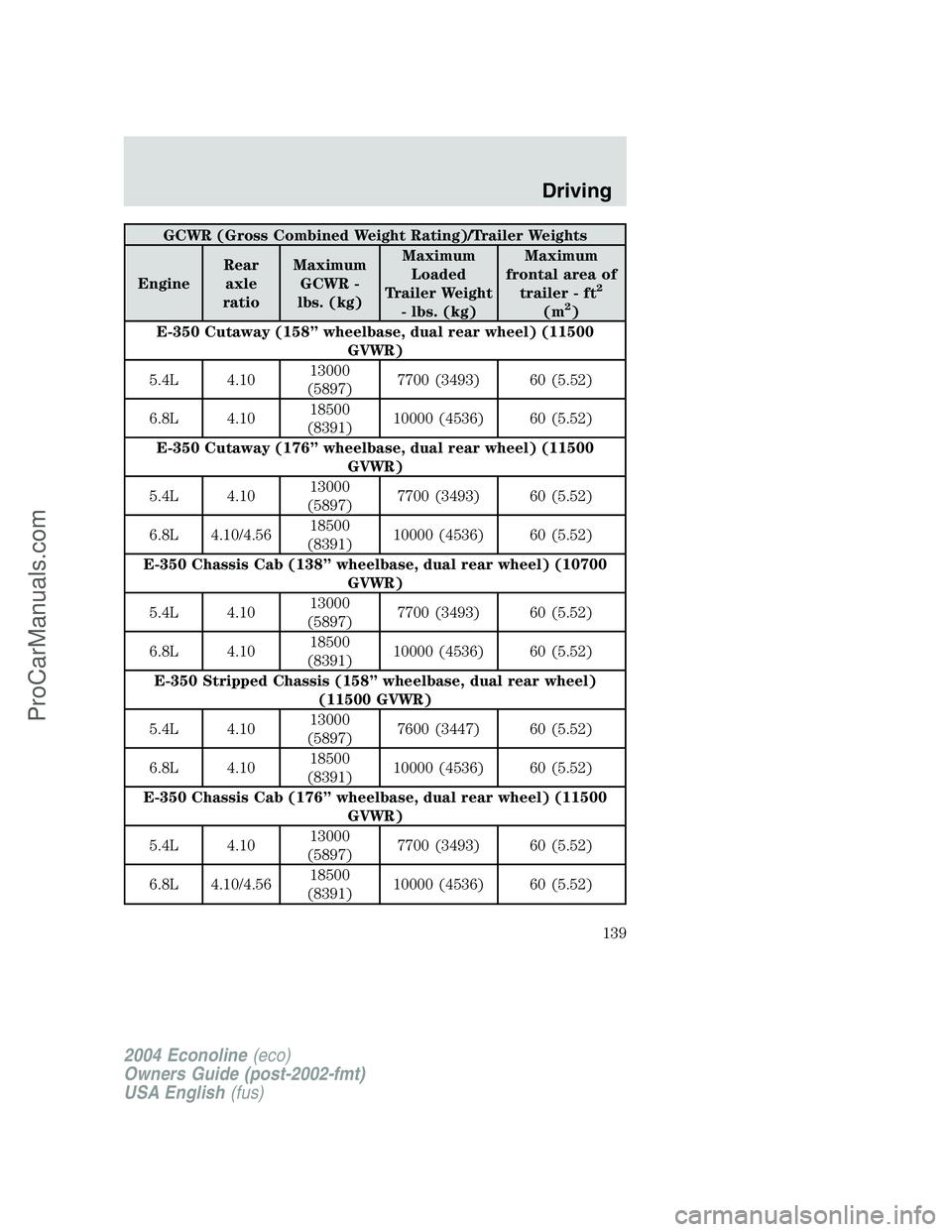
GCWR (Gross Combined Weight Rating)/Trailer Weights
EngineRear
axle
ratioMaximum
GCWR -
lbs. (kg)Maximum
Loaded
Trailer Weight
- lbs. (kg)Maximum
frontal area of
trailer - ft
2
(m2)
E-350 Cutaway (158”wheelbase, dual rear wheel) (11500
GVWR)
5.4L 4.1013000
(5897)7700 (3493) 60 (5.52)
6.8L 4.1018500
(8391)10000 (4536) 60 (5.52)
E-350 Cutaway (176”wheelbase, dual rear wheel) (11500
GVWR)
5.4L 4.1013000
(5897)7700 (3493) 60 (5.52)
6.8L 4.10/4.5618500
(8391)10000 (4536) 60 (5.52)
E-350 Chassis Cab (138”wheelbase, dual rear wheel) (10700
GVWR)
5.4L 4.1013000
(5897)7700 (3493) 60 (5.52)
6.8L 4.1018500
(8391)10000 (4536) 60 (5.52)
E-350 Stripped Chassis (158”wheelbase, dual rear wheel)
(11500 GVWR)
5.4L 4.1013000
(5897)7600 (3447) 60 (5.52)
6.8L 4.1018500
(8391)10000 (4536) 60 (5.52)
E-350 Chassis Cab (176”wheelbase, dual rear wheel) (11500
GVWR)
5.4L 4.1013000
(5897)7700 (3493) 60 (5.52)
6.8L 4.10/4.5618500
(8391)10000 (4536) 60 (5.52)
2004 Econoline(eco)
Owners Guide (post-2002-fmt)
USA English(fus)
Driving
139
ProCarManuals.com
Page 140 of 256
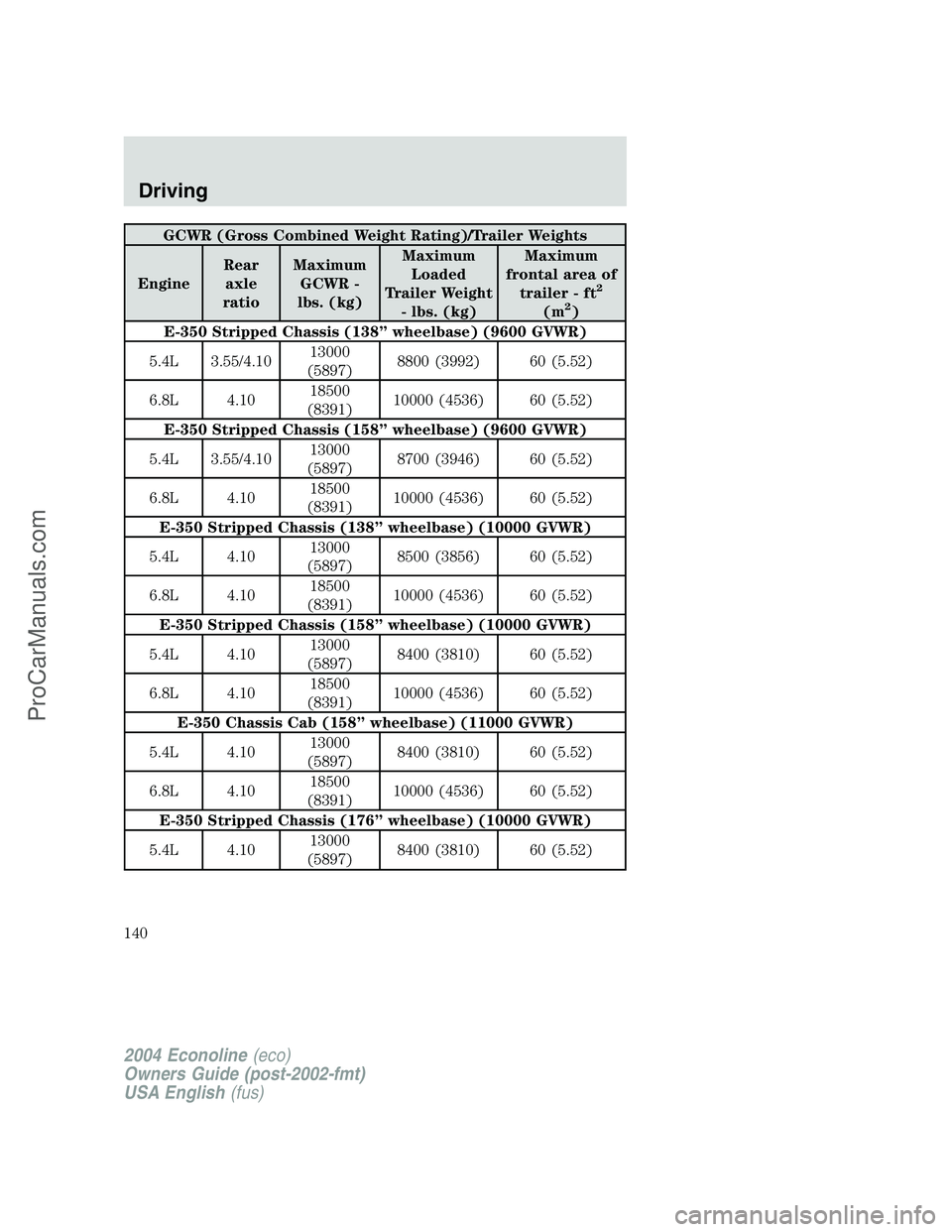
GCWR (Gross Combined Weight Rating)/Trailer Weights
EngineRear
axle
ratioMaximum
GCWR -
lbs. (kg)Maximum
Loaded
Trailer Weight
- lbs. (kg)Maximum
frontal area of
trailer - ft
2
(m2)
E-350 Stripped Chassis (138”wheelbase) (9600 GVWR)
5.4L 3.55/4.1013000
(5897)8800 (3992) 60 (5.52)
6.8L 4.1018500
(8391)10000 (4536) 60 (5.52)
E-350 Stripped Chassis (158”wheelbase) (9600 GVWR)
5.4L 3.55/4.1013000
(5897)8700 (3946) 60 (5.52)
6.8L 4.1018500
(8391)10000 (4536) 60 (5.52)
E-350 Stripped Chassis (138”wheelbase) (10000 GVWR)
5.4L 4.1013000
(5897)8500 (3856) 60 (5.52)
6.8L 4.1018500
(8391)10000 (4536) 60 (5.52)
E-350 Stripped Chassis (158”wheelbase) (10000 GVWR)
5.4L 4.1013000
(5897)8400 (3810) 60 (5.52)
6.8L 4.1018500
(8391)10000 (4536) 60 (5.52)
E-350 Chassis Cab (158”wheelbase) (11000 GVWR)
5.4L 4.1013000
(5897)8400 (3810) 60 (5.52)
6.8L 4.1018500
(8391)10000 (4536) 60 (5.52)
E-350 Stripped Chassis (176”wheelbase) (10000 GVWR)
5.4L 4.1013000
(5897)8400 (3810) 60 (5.52)
2004 Econoline(eco)
Owners Guide (post-2002-fmt)
USA English(fus)
Driving
140
ProCarManuals.com